#Anne Marie Martinozzi
Photo

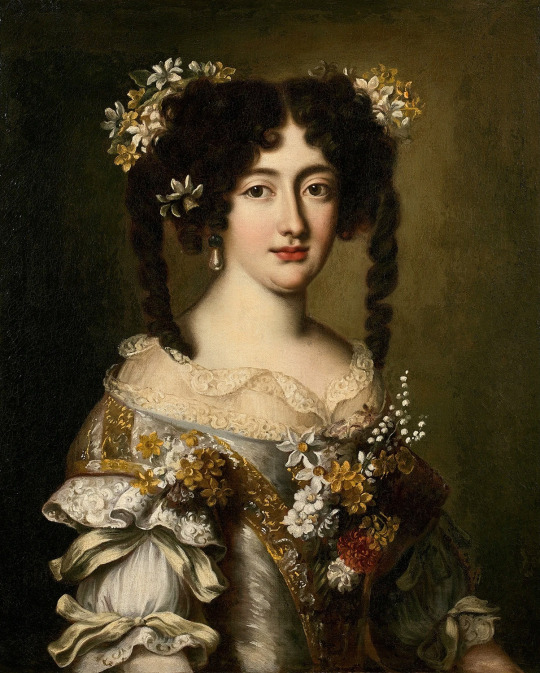
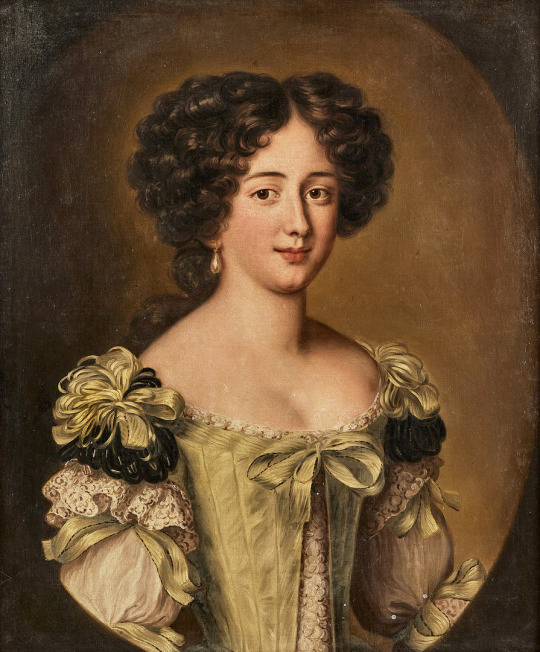



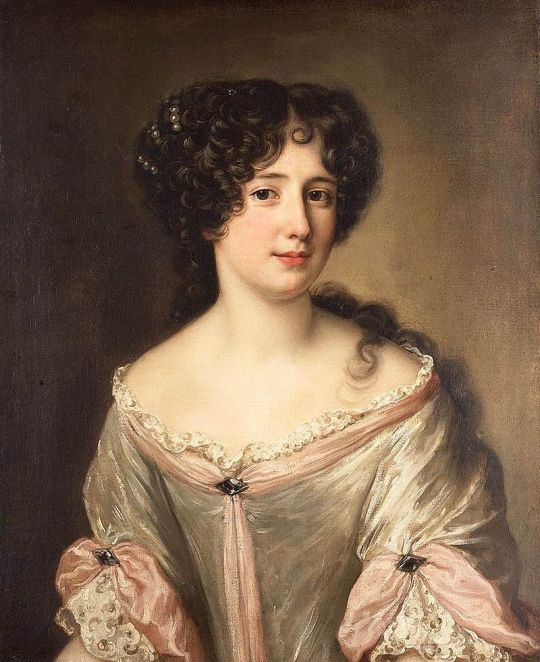
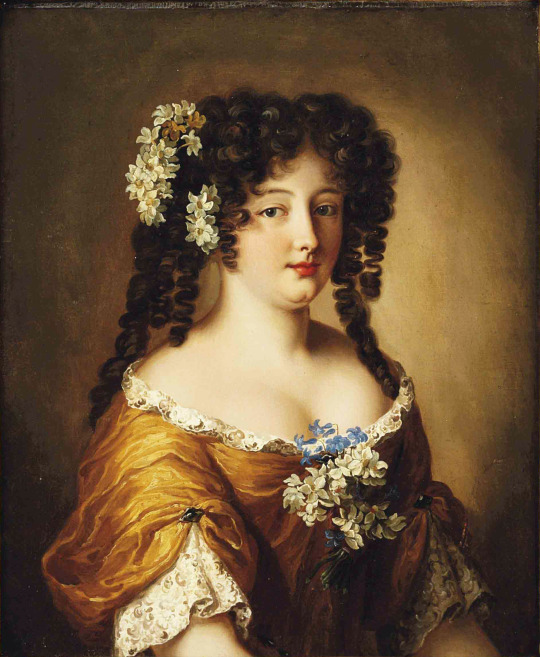
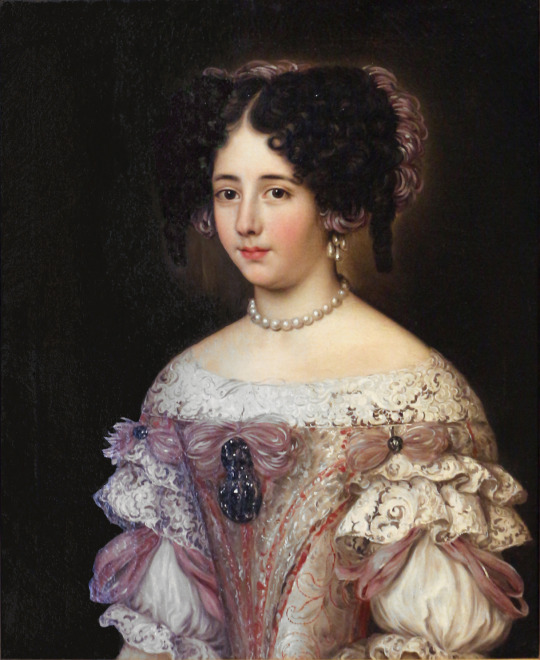
Jacob Ferdinand Voet - different portaits of the Mazarinettes, the collective name which indicated the seven nieces of Cardinal Jules Mazarin (Giulio Mazzarino), chief minister to the Kings Louis XIII and Louis XIV of France.
Their names were: Laura and Anna Maria, daughter of Laura Margherita Mazzarino; Laura, Olimpia, Maria, Ortensia and Maria Anna, daughter of Girolama Mazzarino.
Mazarin wished to establish a dynasty in France and secure his legacy through advantageous marriages, but could have no children of his own as a member of the Catholic clergy. He also wanted to surround himself with his family, in whom he could confide, as he had many enemies at court.
The French royal family supervised the education of the girls. The Queen Regent, Anne of Austria, allowed for the younger children to be educated with the future king Louis XIV and his younger brother, Monsieur Philippe, Duke of Anjou.
Cardinal Mazarin arranged advantageous marriages for his nieces with powerful French and Italian aristocrats, and gave large dowries to their husbands in order to overcome their reluctance to marry women of lower origins. Many of them, in any case, will live more adventurous lives, becoming estimated women of letters or abandoning violent husbands and becoming lovers of kings and other rulers.
#Jacob Ferdinand Voet#flemish art#italian history#Mazarinettes#Marie Mancini#Hortense Mancini#Laura Martinozzi#Olympia Mancini#Anne Marie Martinozzi#Laura Mancini#french history#women history#17th century#17th century history#baroque#Rome
21 notes
·
View notes
Text
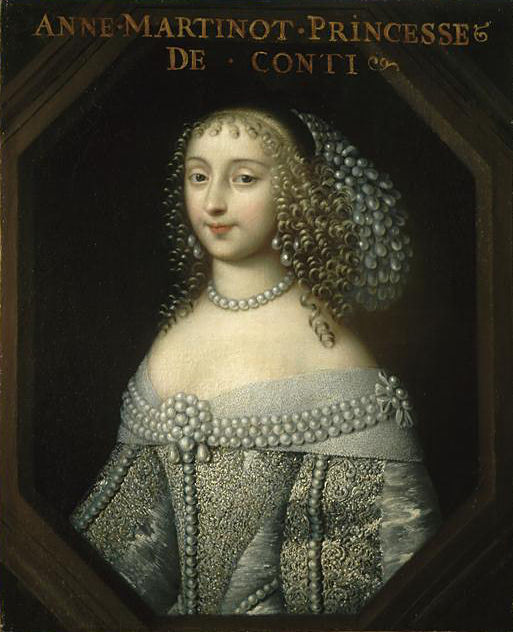
Anne Marie Martinozzi, Princess of Conti (1637 – 4 February 1672) was a French aristocrat and court official. She was a niece of King Louis XIV of France's chief minister Cardinal Mazarin, and the wife of Armand de Bourbon, Prince of Conti. She became the mother of the libertine François Louis, Prince of Conti, le Grand Conti. Her marriage to the Prince of Conti made her a princesse du Sang. She served as Surintendante de la Maison de la Reine for the queen dowager, Anne of Austria, between 1657 and 1666.
4 notes
·
View notes
Text
The dangers of disgrace- Can you save the family patrimony ?
Royal favour was so actively cultivated because political credit opened the doors to the further accumulation of wealth and even those well beyond the comparatively narrow confines of the court received pensions or other marks of distinction which meant that disgrace could have serious financial consequences. By the seventeenth century, France was governed by the rule of law in as much that life and property were not subject to royal whim. Rather than justice being exercised by the monarch personally, authority was delegated to courts and other individuals or institutions even if it was always subject to evocation should the need arise. Shocking exceptions such as the assassinations of the Guise or of Concini on the orders of Henri III and Louis XIII respectively were, it is true, covered by the flimsiest of legal fig leaves, thereafter trials of one form or another had been held for many of those who had fallen into the profoundest disgrace. For all of their theoretical power, Bourbon kings saw themselves as absolute monarchs not tyrants or despots, and property or offices were rarely confiscated in the manner of Russian tsars or Ottoman sultans. Yet if this offered French elites some degree of security, disgrace could still leave the family patrimony highly vulnerable.
Both the duc de Montmorency in 1632 and the Grand Condé in 1653 were condemned for the crime of lese-majesty after taking up arms against the crown and the potential consequences for their family patrimonies were nothing short of catastrophic. Before his execution, the rebel duc was declared "deprived of all rank, honours, and offices, the duchy of Montmorency extinguished and reunited to our crown and all of his other estates, seigneuries, properties, and goods, confiscated in our name." Condé fared no better and he was deprived of his "honours and governorships" by a royal declaration of November 1652 and dispossessed of "all his houses, lands, and properties to the profit of the king" by an arrêt of the Parlement of Paris in March 1654. If such draconian sentences could be handed down to two of the most prestigious men in the kingdom, it is easy to imagine the potential vulnerability of those lower down the social hierarchy, and when faced by harsh public and legal condemnation saving the family fortune was no easy task.
Guilty of lese-majesty, and with Richelieu determined to make an example, Montmorency lost his head and any right to influence the future destination of his patrimony. Yet rather than bolster the royal domain, Louis XIII respected the wishes of the rebel's father, who before his own death had planned to divide his inheritance amongst his three daughters should his son die without heir. By this route, a substantial portion of the vast Montmorency inheritance had passed to the Bourbon-Condé via Charlotte-Marguerite de Montmorency, wife of the prince de Condé. It was their son, the great military captain, who had by his own treason during the Fronde endangered that inheritance and much else besides. Moreover, unlike the duc in 1632, he had not expiated his crimes on the block and was instead fighting in Spanish service against Louis XIV's armies in Flanders while his brother, Conti, and most of his relatives and clients were suspect having participated in one way or another in his revolt. There was, therefore, a genuine danger that the family patrimony would be broken up or lost.

The House of Bourbon-Condé rose to the challenge. The task of safeguarding the family fortune was rendered possible in large measure because the judgement confiscating Condé's possessions was issued in absentia and despite its draconian terms it left the door "open for repentance" and allowed five years for an appeal to be lodged. That delay bought valuable time, even if the presence of the notoriously avaricious Mazarin waiting in the wings was a warning that it might not be enough. In response, the princely House and its entourage was mobilized and it promptly began to squirrel away jewels, furniture, works of art, and other valuables, literally stripping châteaux and hôtels and hiding anything of value away from the prying eyes of its enemies. Legal manoeuvres allowed the family to open up another front as almost everyone from the prince de Conti to household servants took the opportunity to make a legal claim against the absent Condé's estate. Having made his peace with the cardinal, Conti cemented his new found favour by marrying Marie-Anne Martinozzi, one of Mazarin's nieces. While hardly a prestigious match, the political advantages were all too tangible as he could now stake a claim to the offices and titles forfeited by his brother. By these and other means, the Condé fortune was saved from rapine and when, in 1660, the prince was permitted to re-enter the kingdom disaster had been averted. His rehabilitation, which had been negotiated as part of the Peace of the Pyrénées concluding the long war with Spain, was a rare example of political disgrace being ended by diplomatic treaty. It would, however, take several years before the damage to Condé's political and financial credit had been repaired, and he was once more trusted to serve at the head of Louis XIV's armies.
Julian Swann- Exile, Inprisonment or Death- The Politics of Disgrace in Bourbon France
#xvii#julian swann#exile inprisonment or death: the politics of disgrace in bourbon france#henri i de guise#concino concini#henri iii#louis xiii#henri ii de montmorency#louis ii de bourbon condé#le grand condé#charlotte-marguerite de montmorency#cardinal de richelieu#louis xiv#armand de bourbon conti#marie-anne martinozzi#cardinal mazarin#treaty of the pyrénées
3 notes
·
View notes
Text

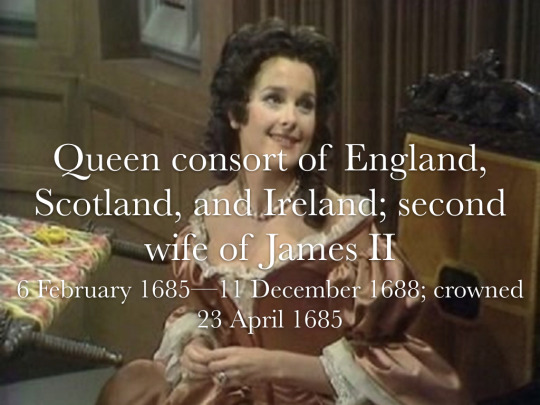
Queen consorts of England and Britain | [43/50] | Mary of Modena
Mary was Queen consort of England, Scotland, and Ireland from 1685 until 1688 as the second wife of James II and VII. She was born on 5 October 1658 as the daughter of Alfonso IV, Duke of Modena and Laura Martinozzi. Mary’s mother was quite strict but she still had a great education. She was fluent in French, Italian, Latin, and English. Mary’s mother originally hoped for her to marry Charles II of Spain, however, eventually she consented to a match with James, Duke of York and the two were married by proxy on 30 September 1673 when Mary was just shy of turning 15 and James was almost 40. As Mary was Catholic, she was not received well in England. Parliament threatened to have the marriage annulled so James’ brother, King Charles, suspended Parliament for a few months to ensure the marriage was honored. Mary met James for the first time on 23 November 1673 on the day of their official wedding. James was pleased with her but Mary disliked him and burst into tears upon seeing him. From his first marriage, James had two daughters, Mary and Anne, who were only a few years younger than Mary. Princess Anne immediately disliked Mary, but Princess Mary was more affectionate with her step-mother. Starting in 1678, there was a plot to bar James from the throne since he was Catholic. This plot forced James and Mary into exile in Brussels. Not long after, James and Mary returned to England when they heard Charles was ill. They feared that Charles’ oldest illegitimate son would try to take the throne in their absence if Charles died. Charles survived the illness and sent James and Mary back into exile, this time in Edinburgh. During the exile, they were separated from their only living child, Isabel, which caused Mary to fall into a depression. Israel ended up dying at only 4 years old which caused Mary’s depression to worsen even to the point where it worried her physicians. Despite the plot to try and exclude James from inheriting the throne, James managed to succeed after his brother’s death on 6 February 1685. James and Mary had a joint coronation on 23 April 1685 which was the first full-length joint coronation since Henry VIII and Catherine of Aragon almost 200 years earlier. Mary’s health had still not recovered after the death of her daughter, Isabel, and another daughter, Charlotte who died after three weeks, and people had even begun to plan for Mary’s death. On 10 June 1688, Mary gave birth to a son named James. Catholics rejoiced at the Prince’s birth but Protestants were immediately concerned due to fear that this was the beginning of a new Catholic dynasty. Shortly after the Prince’s birth, James’ son-in-law was invited to England in what would become known as the Glorious Revolution. Prince James was stripped of his status as heir and King James and Mary were forced to flee into exile. James was officially deposed on 11 December 1688 and his daughter, Mary, and her husband, William, who were Protestants, were made joint monarchs. James, however, still considered himself king by divine right and believed Parliament had no right to depose him. Louis XIV of France supported James’ cause and he and Mary set up their own court in France. James was largely excluded from the French court as the nobles found him boring, however, Mary was hugely popular. She was treated as a queen and became good friends with Louis XIV. And since there was no queen or dauphine at the time, Mary took precedence over all the other women at court. Mary helped financially support James when he tried to reclaim the throne and also tried to help his followers who were living in poverty. James never succeeded in reclaiming his throne and eventually died on 16 September 1701. Louis XIV had Mary’s son declared James III of England and Mary was named nominal regent and head of his regency council although she disliked politics. Mary’s first act as regent was to lay out James’ claim, but this was ignored in England. In Scotland, however, they asked Mary to surrender James into their custody where he would be converted to Protestantism and therefore could
inherit the throne but Mary refused this offer. When King William of England died in 1702, some Scottish nobles declared for James, however, Mary refused to part with James so the rising never came to pass. Shortly afterwards, Mary’s regency ended when James turned 16. After this, Mary decided to seek refuge in a convent to escape the stress of exile. In 1711, James was forced to flee France and Mary’s only other surviving child died sending Mary into another depression. She never recovered from this, spending the rest of her life living, impoverished, in a convent, eventually dying of cancer on 7 May 1718.
11 notes
·
View notes
Text
Marie-Thérèse d’Autriche
Marie-Thérèse d’Autriche was born on September 10 in 1638, five days after her future husband, which made many believe they were meant for each other. Marie-Thérèse d’Autriche in circa 1645, painted by Juan Bautista Martínez del Mazo. Metropolitan Museum of Art. As daughter of the reining King of Spain Philip IV and his Queen Élisabeth de France, sister of Louis XIII, Marie-Thérèse was Infanta of…
View On WordPress
#Anne d&039;Autriche#Anne Marie Martinozzi#Diego Rodríguez de Silva y Velázquez#Elisa Lasowski Marie-Thérèse Versailles#Élisabeth de France#Henriette d&039;Angleterre#Henriette Marie de France#Hortense Mancini#Las Meninas#Louise de La Vallière#Madame de Maintenon#Madame de Montespan#Madame de Venel#Madame Scarron#Marguerite-Yolande de Savoie#Marie Anne Mancini#Marie Mancini#Marie-Thérèse d&039;Autriche#Marriage of Louis XIV#Olympe Mancini#Philip IV of Spain#Wedding of Louis XIV#wife of Louis XIV
1 note
·
View note
Photo
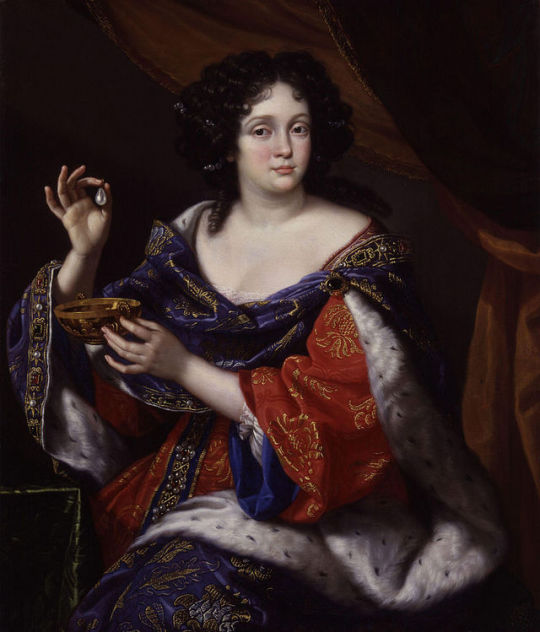
Portrait of Marie-Anne Martinozzi (née Mancini), Duchess of Bouillon
Benedetto Gennari II, 1672
#painting#art#portrait#Benedetto Gennari II#woman#Marie-Anne Mancini#red#blue#fur#cape#sleeves#curls#drapery#17th century#1670s
63 notes
·
View notes
Photo
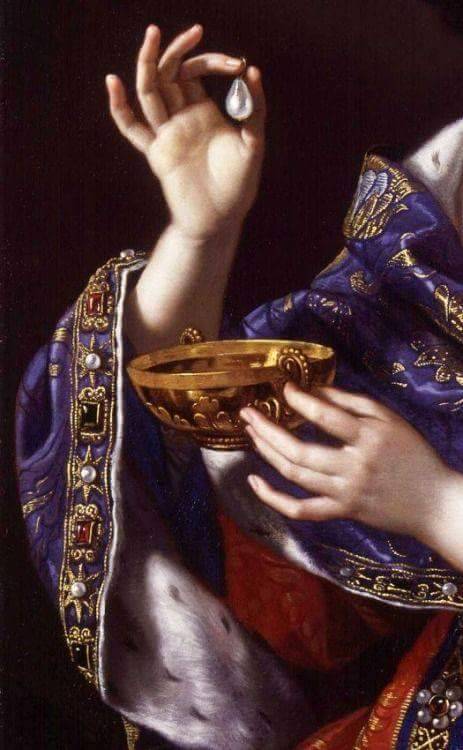
"Marie-Anne Martinozzi (née Mancini), Duchess of Bouillon" Pintura de Benedetto Gennari
0 notes
Photo

Marie-Anne Martinozzi (née Mancini), Duchess of Bouillon by Benedetto Gennari
61 notes
·
View notes
Text
Louis-Armand de Bourbon, Prince de Conti
Louis-Armand de Bourbon, Prince de Conti
Louis-Armand was born in Paris on 4 April in 1661 to Armand de Bourbon and his wife Anne-Marie Martinozzi, and thus a Prince du Sang. Louis-Armand de Bourbon, Prince de Conti His papa, Armand de Bourbon, was the brother of the famous Grand Condé and both brothers mingled in the Fronde. The regain his favour with the King, Armand married Anne-Marie Martinozzi, a niece of Cardinal Mazarin. Armand…
View On WordPress
0 notes
Text
Laure Mancini, Duchesse de Mercœur
Laure Mancini, Duchesse de Mercœur
Laure Mancini was the eldest of the five Mancini sisters. Born on May 6, 1636, she was called to France by Cardinal Mazarin, along with her sister Olympe and cousin Anne Marie Martinozzi, in 1647. Laure Mancini, Duchesse de Mercœur Upon arriving in France, Laure adopted, like the rest, the French spelling of her name, Laure-Victoire Mancini. Due to the influence of their uncle, Cardinal Mazarin,…
View On WordPress
#Anne Marie Martinozzi#Cardinal Mazarin#Duchesse de Mercœur#Laure Mancini#Marie Anne Mancini#Mazarinettes#Olympe Mancini
0 notes